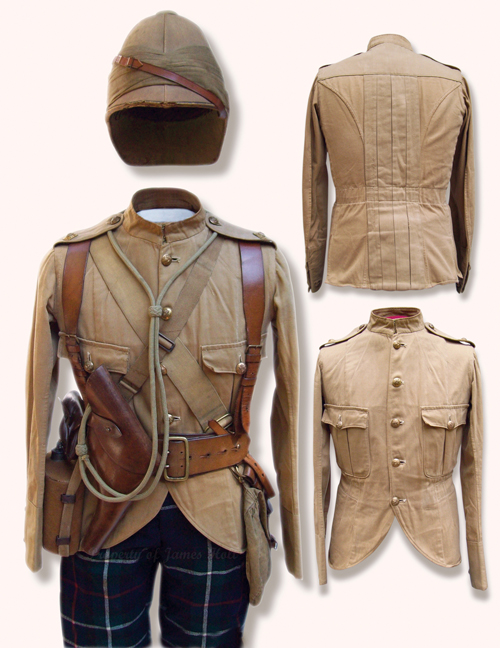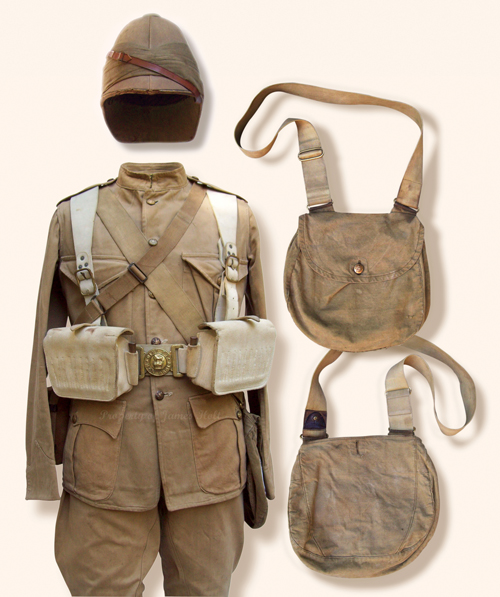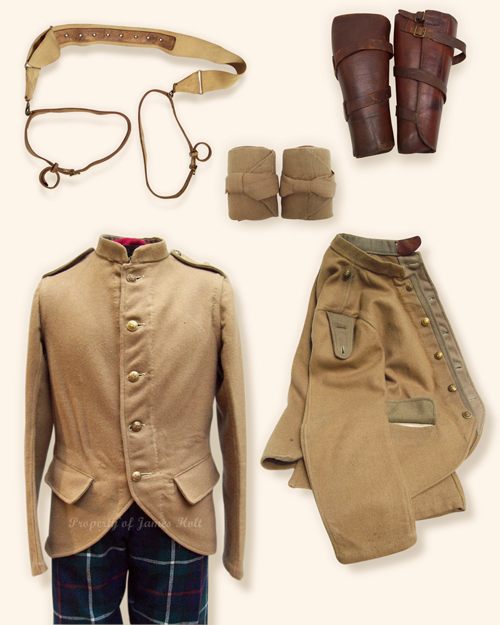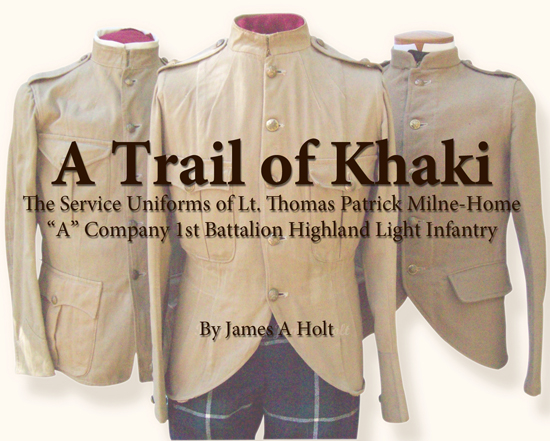Thomas Patrick Milne-Home
Born: 1875
Died: 1956
Commissioned: 1st Battalion Highland Light Infantry 6 March 1895
Lieutenant: 3 February 1898
Captain: 1 April 1901
Milne-Home saw service in Crete, 1898, and in the Anglo Boer War, 1899-1901, where he was present at the Battle of Magersfontein (11 December 1899), Retief’s Nek (23-24 July 1900), the skirmish at Wittpoort (14 August 1900), was wounded in action at Dewetsdorp (23 November 1900) and Court Martialed 29 January 1901 for “Shamefully delivering up a post.” Exonerated, reinstated, and promoted to Captain April 1901. Battalion strength upon Embarkation October 23 1899 was 1,111 all ranks.
On the 7 October 1899, the mobilization of the South African Field Force commenced owing to failing relations between Her Majesty’s Government and the South African Republics of the Transvaal and the Orange Free State. All reserves of sections A, B, and C of the 1st Battalion Highland Light Infantry were called out and notified that it would form part of General Wauchope’s 3rd Brigade of 2nd Division. Along with the 1st HLI was the 2nd Battalion Black Watch, 2nd Battalion Seaforth Highlanders, and 1st Battalion Argyll & Sutherland Highlanders. Under the command of newly promoted Lt.Colonel Kelham, the 1st Battalion HLI embarked 23 October 1899 with the rest of the “Highland” Brigade from Southampton Docks aboard the Transport Aurania, bound for Port Elizabeth, South Africa.
The khaki doublet adopted by the officers of the 1st Battalion HLI embodied some unique features. The gauntlet styled cuffs bore three buttons to each, two at the front with one to the rear, a low stand collar, (which resembled those of the men’s), and an interesting arrangement of pleats to the back of the doublet. Legend has it a tailor was instructed to sew four loops spaced 4 inches apart at the center of the back. Two loops at the bottom of the shoulder yoke and two on the bottom edge of the doublet. These were to be used to accommodate the hooks of the spine pad in use at the time. Instead the tailor had sewn four 1inch box pleats down the center of the back from the shoulder yoke to the bottom edge of the khaki doublet. This “error” however, met with the approval of the Officers, and eventually transitioned to become the regimental “Sealed Pattern.”

The regimental pattern khaki doublet worn by Milne-Home along with his Mackenzie tartan breeches and private purchase haversack. The fully equipped display would give an accurate impression of how Battalion officers of the HLI would have appeared in early November 1899. (James Holt collection)
Milne-Home and the Brigade arrived at the Cape 11 November 1899. The officers and men were wearing khaki doublets and Mackenzie Tartan trews (some officers wearing tartan breeches). Officers carried their load with double braced Sam Browne belt rigs and a khaki web carrier with buff leather straps for their greatcoats, while the men were equipped with the 1888 Valise Equipment. By 19 November 1899, the 1st Battalion HLI were concentrating at DeAar. According to regimental records, it was at this time that the Battalion went into khaki trousers and puttees, discarding tartan trews for the time as being “too conspicuous.” Officers gave up their swords, put on “men’s belts” and took up rifles to assimilate themselves to the men in action.

Map taken from an 1899 world atlas showing the area of operations of the1st Battalion Highland Light Infantry November 1899 – May 1900, before moving north to Dewetsdorp and eventually south again to Aliwal North. (James Holt collection)

Milne-Home had in his possession this 1899 pattern other ranks khaki frock. He has added two lower flapped hip pockets with button closure. Milne-Homes’ haversack is typical of what was available to officers for purchase. The khaki breeches also belonged to Milne-Home and he would have worn these rather than his tartan breeches as of November 19 1899. Perhaps Milne-Home appeared as above when the regiment marched to Magersfontein. (James Holt collection)
Shortly after midnight the morning 11 December 1899, the Highland Brigade advanced on Magersfontein in a heavy rain. The brigade’s 30 companies were placed in quarter columns, the 2nd Black Watch in the lead followed by the 2nd Seaforth’s and 1st A&SH,with 1st HLI as reserve. The HLI were, for the most part, spared the carnage suffered by the rest of the brigade that day losing 2 officers and 12 men killed with 7 officers, including Colonel Kelham, and 73 men wounded. Corporal J Shaul, 1st HLI, for his coolness under fire in attending the wounded, earned the V.C. for his bravery.
As the brigade licked their wounds and moved off toward Paarderberg, the HLI stayed behind at Klip Kraal. In the weeks/months that followed, they were reinforced with a draft of 96 NCOs and men, Reservists and Militia under Capt. Jones 3rd HLI. According to the records, sometime between 30 April and 4 May 1900, the whole regiment was re-clothed in khaki serge. It was at this time Milne-Home obtained his 1899 pattern other ranks serge frock (which Milne-Home had modified to a more appropriate “Highland cut” front). This would seem an opportune time of “re-clothing” with serge frocks as the temperatures start to fall between May and September, June being the coldest with an average high of 15C and a low of -1C.
By 1 May 1900, the regiment rejoined the brigade in the advance from the Waterworks to Heilbron en-route to encircling Prinsloo’s force in the Brandwater Basin. During this operation the HLI were involved in gaining a foothold during the skirmish at Retief’s Nek 23 July 1900. While conducting mopping up operations in the Bethlehem-Heilbron District after Prinsloo’s surrender the regiment was engaged in action at Wittpoort 14 August 1900 sustaining casualties of 3 men killed ,Colonel Kelham and 40 men wounded. Between August and October, the brigade moved to the Orange River Colony in response to the Boer build up along the Cape Colony Border, and took part in a small action south of the Yet River 13 September 1900. Shortly following the action the brigade was split up, indeed part of the regiment too, Headquarters and 3 Companies B, I , and K, 1st Battalion HLI, advanced to Wepner. Two companies, A, and a Volunteer company under Major Anson were ordered to Dewetsdorp. By 17 November Dewetsdorp was garrisoned by A Company 1st HLI, three companies of the 2nd Gloucesters, and a handful of men from the Royal Irish Rifles, and two guns of the 68th Battery RA. On 18 November the town was besieged by General DeWet’s force of just over 2,000 men, and fought hard until 23 November. Owing to a lack of water, mounting casualties, and himself wounded, Milne-Home surrendered his position to the Boers. An “unacceptable alternative.” The Battalion did have a bright spot in Pvt. Charles Kennedy of A company who carried a comrade quite some distance to safety on the 22nd under a withering fire, again on the 23rd he ventured into “certain death” to deliver a message. His steadfast courage and intestinal fortitude earned him the Victoria Cross. Lt. Thomas Patrick Milne-Home on the other hand was not so venerated. He was Court Martialed in Bloemfontein 29 January 1901, for surrendering his post at Dewetsdorp, and “Dismissed the Service.” Having family and friends of some influence, perhaps Colonel Kelham himself, Milne–Home’s case was reopened by order of King Edward VII in March 1901 and Milne-Home was exonerated and reinstated. On 1 April 1901 (April Fools’ Day) Milne-Home was promoted Captain, while another scapegoat, Harry Harbord Morant, obtained his commission as a Lt. in The Bushveldt Carbineers.

Lt. Milne-Homes 1899 pattern serge frock, tailored to a cutaway front. Note the varying shades of serge material used in its construction. Also displayed are his greatcoat carrier, his puttees, and his leather gaiters. (James Holt collection)
It is interesting to speculate, in fact tempting to say with any certainty, which frock Milne-Home was wearing and when. I have tried to be academic and methodical and present my research in an order I believe the frocks were worn based on regimental orders, directives, and re-supply. (Not to mention the varying condition of the frocks themselves).
James Holt
Special thanks to Benny Bough and Peter Kennedy.
Sources:
- Regimental Records, 1st Battalion Highland Light Infantry (Formerly the 71st Foot)
- “Proud Heritage”, Vol.III (History of the HLI) 1882-1918 Lewis Balfour Oats
- South African War Casualty Roll: The South African Field Force 1899-1902
- Highland Light Infantry, Uniforms of the Regiment 1881-1914, James B. McKay, Douglas Anderson.
- Harts Army List, 1895, 1898, 1901
- Manual of Military Law, War Office 1899
- Scottish Military Research Group, http:/scottishmiliyary.blogspot.com
- World Wide Weather Online (World averages of Temperature)


Outstanding Jim, great research, article and uniform. Your collection is second to none.
OUTSTANDING COLLECTION! I just recently became interested in Boer War artifacts.Your collections is truly outstanding. I just recently picked up a salty pith with highlander tartan flash. I would love to show it, if I could figure out how to attach it to this reply.
Chuck
you have to upload the image to an intermediate site like Photobucket.com and copy the URL code then paste it into the comment. If you can see the img button in the comment editor, you may have to go back in and edit your original comment, click that and enter the URL.
Here is an example of the URL I used above in the img box, http://i88.photobucket.com/albums/k186/stuart_bates/KRRCFront.jpg
It’s very easy once you have done it once.
Stuart
Perhaps some additional info on this officer:
http://scottishmilitary.blogspot.com/2011/06/captain-thomas-patrick-milne-home.html